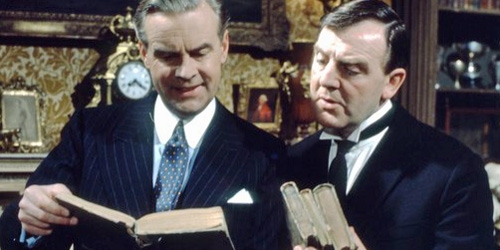Dorothy L. Sayers
1923
(A financier goes missing and a lookalike is found dead in a bathtub. The easygoing Lord Peter Wimsey searches for the connection.)

As troubling as murder is in our society, more of them happen on bookstore shelves than anywhere else, and millions of apparently peaceful people pay plenty of money to read about them, as if it were a pity that they don’t happen more often. I have casually wondered why. Probably it is an example of entertainment by extremity: if conflict is the heart of any good story, surely lots of people will go for people killing each other, since you can’t get more conflictual than that. This doesn’t really answer the question, though—it just passes the buck from fascination with murder to fascination with conflict in general. But of course we humans are inherently scenario-building, personality-scrutinizing, lie-detecting social beings. Human success has always depended on figuring other people out. The fact that one of the characters in such stories is likely to be the murderer is probably a large part of the draw. Trying to solve a murder mystery flexes the same mental muscles that we use for everyday social problem-solving and monitoring. And a murder is, again, more likely to catch our attention than any other breach of social mores. The authors make the stakes so high to ensure our attention. Not everyone goes in for these books, of course, which is simply because our society provides us with a variety of different ways to address basic human concerns. Take an EEG of a video gamer, sports follower, or romance reader at their respective hobbies; I suspect they are scratching the same itches in different ways.
 Dorothy Sayers is a master of the detective novel genre, which is really the classic root from which all of our mystery, crime, “hidden secret”, and even many horror stories have sprouted. She wrote during the “Golden Age” of detective fiction, standing on the shoulders of the secure British foundation of Collins, Doyle, Chesterton, and Bentley (although one could argue that they all are indebted to Poe across the pond). Although Agatha Christie wrote more novels and may be more widely read today, I doubt it is very controversial to say that Sayers deserves the primary honor in that Golden Age. She not only has ingenious plots (perhaps the most critical ingredient in a detective novel), but also insightful characterization, an elegant style, and a background that is meticulously researched without being paraded.
Dorothy Sayers is a master of the detective novel genre, which is really the classic root from which all of our mystery, crime, “hidden secret”, and even many horror stories have sprouted. She wrote during the “Golden Age” of detective fiction, standing on the shoulders of the secure British foundation of Collins, Doyle, Chesterton, and Bentley (although one could argue that they all are indebted to Poe across the pond). Although Agatha Christie wrote more novels and may be more widely read today, I doubt it is very controversial to say that Sayers deserves the primary honor in that Golden Age. She not only has ingenious plots (perhaps the most critical ingredient in a detective novel), but also insightful characterization, an elegant style, and a background that is meticulously researched without being paraded.
Whose Body?, an early work (published when Sayers was 30), begins with the debonair Lord Peter Wimsey being torn between two loves: buying a rare book and solving a crime. Fortunately his resourceful manservant Bunter can be trusted to get the book while Wimsey visits the crime scene. A man has been found naked in a tub—not at all unusual, except that he is dead. (This is an example of the kind of whimsy one can expect from the main character). The victim wears nothing but a pince-nez. A bit of observation reveals that he is a normally grimy person who has apparently come into wealth and cleanliness very recently. Moreover, he strangely resembles, though only superficially, a financier named Reuben Levy who went missing on the same night. The knuckleheaded police investigator Sugg arrests the poor Thippses whose tub was occupied in so peculiar a fashion, while Wimsey, his man Bunter, and a detective Parker follow leads elsewhere. Without the miraculous coincidences, flawless memories, and crucial trivialities of most other authors in the genre, but in an agonizingly “I should have thought of that” ending, Sayers permits Wimsey, and us, to realize whodunit at about 3/4 of the way through the novel.
Download this SPOILER if you want the ending revealed.
Tidbits of Significance
“You’re a demon for coffee, Bunter—I don’t want to know how you do it, because I believe it to be witchcraft, and I don’t want to burn eternally.”
-Lord Peter to Bunter, ch.2.
“There is nothing you can’t prove if your outlook is only sufficiently limited.”
-Lord Peter, ch.5.
Tips
READ THIS WHEN…
…you would like to savor a gentile pastime, but are prepared for something a bit more dangerous than cricket or book-collecting;
or,
…your mental muscles are poised for action and you believe you just might be witty enough to solve a good murder mystery.
IF YOU LIKED THIS, YOU’D ALSO LIKE:
(for the vicarious master of deduction:)
- Edgar Allan Poe, “The Murders in the Rue Morgue” (1841)
- Wilkie Collins, The Moonstone (1868)
- Arthur Conan Doyle, The Adventures of Sherlock Holmes (1892)
- G. K. Chesterton, The Innocence of Father Brown (1911)
- E. C. Bentley, Trent’s Last Case (1913)
(for the steadfast admirer of the indomitable Lord Peter Wimsey:)
- Dorothy L. Sayers, Clouds of Witness (1927)
- Dorothy L. Sayers, Murder Must Advertise (1933)
- Dorothy L. Sayers, The Nine Tailors (1934)
- Dorothy L. Sayers, Gaudy Night (1936)
Find It!
Hardcover: The readiest hardcovers to find new are independently published and of questionable quality. Better to go used at this point: one handy edition by Avenel books also includes three other Lord Peter Wimsey novels.
Paperback: Dover edition, the current best seller.









